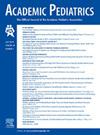Effect of Price on Women, Infants, and Children-Eligible Caregiver Participation in a Produce Program: A Randomized Trial
IF 2.8
3区 医学
Q1 PEDIATRICS
引用次数: 0
Abstract
Objective
This pilot randomized trial examined the associations between price, participation of women, infants, and children (WIC)-eligible families in a produce delivery program and reported healthy eating behaviors.
Methods
Fifty caregivers of WIC-eligible children from an urban primary care center enrolled in an 8-week produce delivery program. Participants received free produce boxes for the first 4 weeks and were randomized to a cost of $5 or $10 per box for the remaining 4 weeks. Weekly orders were tracked, and longitudinal surveys were conducted to assess the program's impact on healthy eating.
Results
Forty-three caregivers (86%) participated in the study. An average of 35.3 (SD 5.74) participants ordered weekly during the free period with a significant drop-off to 18.3 (SD 0.96) ordering weekly during the paid period (P<.001); most (73%) participants paid with SNAP benefits. There was no significant difference in average orders between the $5 and $10 groups (12.25 [SD 4.4] vs 14.5 [SD 5.63], P = .19). Participation was significantly associated with an increase in reported produce access (53% vs 97%, P<.001) and ability to eat healthy (34% vs 61%, P = .04).
Conclusions
Our study found that participation in a delivery-produce program decreased significantly with introduction of cost and use of food assistance benefits to purchase produce was common among sustained participants. Participants reported improvements in healthy eating and ability to access produce. Future study is needed to further evaluate price points to optimize program sustainability and participation and the impact of produce delivery programs on childhood produce intake.
Clinical Trial Registration
ClinicalTrials.gov, NCT05153577
价格对符合wic条件的护理人员参与农产品项目的影响:一项随机试验。
目的:这个试点随机试验检查了价格、wic合格家庭参与农产品配送计划和报告的健康饮食行为之间的关系。方法:来自城市初级保健中心的50名符合wic条件的儿童的护理人员参加了为期8周的生产分娩计划。参与者在前4周收到免费的农产品箱,在剩下的4周随机选择每箱5美元或10美元。跟踪每周的订单,并进行纵向调查,以评估该计划对健康饮食的影响。结果:43名护理人员(86%)参与了本研究。在免费期间,平均有35.3(标准差5.74)参与者每周订购,而在付费期间,每周订购的参与者显著下降至18.3(标准差0.96)(P < 0.001);大多数(73%)参与者使用SNAP福利支付。5美元组和10美元组的平均订单量无显著差异(12.25 [SD 4.4] vs. 14.5 [SD 5.63], P = 0.19)。参与与报告农产品获取的增加(53%对97%,P < 0.001)和健康饮食的能力显著相关(34%对61%,P = 0.04)。结论:我们的研究发现,随着成本的引入,参与农产品交付计划的人数显著减少,使用粮食援助福利购买农产品在持续参与者中很常见。参与者报告说,他们在健康饮食和获取农产品的能力方面有所改善。未来的研究需要进一步评估价格点,以优化项目的可持续性和参与性,以及农产品交付项目对儿童农产品摄入的影响。临床试验注册:ClinicalTrials.gov, NCT05153577。
本文章由计算机程序翻译,如有差异,请以英文原文为准。
求助全文
约1分钟内获得全文
求助全文
来源期刊

Academic Pediatrics
PEDIATRICS-
CiteScore
4.60
自引率
12.90%
发文量
300
审稿时长
60 days
期刊介绍:
Academic Pediatrics, the official journal of the Academic Pediatric Association, is a peer-reviewed publication whose purpose is to strengthen the research and educational base of academic general pediatrics. The journal provides leadership in pediatric education, research, patient care and advocacy. Content areas include pediatric education, emergency medicine, injury, abuse, behavioral pediatrics, holistic medicine, child health services and health policy,and the environment. The journal provides an active forum for the presentation of pediatric educational research in diverse settings, involving medical students, residents, fellows, and practicing professionals. The journal also emphasizes important research relating to the quality of child health care, health care policy, and the organization of child health services. It also includes systematic reviews of primary care interventions and important methodologic papers to aid research in child health and education.
 求助内容:
求助内容: 应助结果提醒方式:
应助结果提醒方式:


